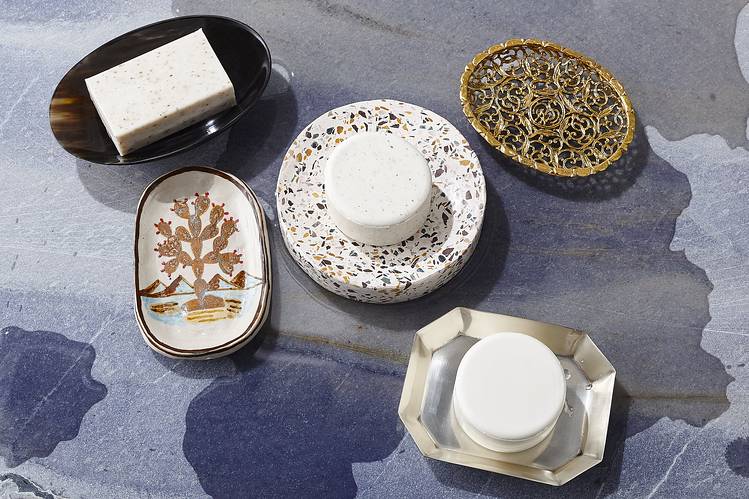Hard-milled cakes are making a comeback, and many decorators applaud the choice. Find out why it’s good, clean fun.
Not very long ago, many of us gave up solid soap for the liquid version, happy to bid adieu to the gelatinous mess that inevitably accrued underneath a bar of soap and to the anxiety (fallacious, it turns out) that it could pass along germs.
Recently, however, some consumers horrified by the trillions of tons of plastic making its way to the oceans are feeling obliged to return to paper-wrapped milled soap, not least because it’s an excuse to buy a handsome holder for it. “I’ve always hated pump soaps,” says Todd Nickey, interior designer and co-owner of hip home goods store Nickey Kehoe in Los Angeles.
“Bar soap in a dish adds a layer of decoration and personality to a powder room.”
The kitchen sink, too, can be made less utilitarian with a cake of soap in a thoughtfully selected tray. Gwen Whiting, who co-founded The Laundress, a producer of home-cleaning products that includes a Kitchen Soap Bar for hands and wooden utensils, elevates bricks of soap with silver and porcelain pieces. “I think it’s nice to use a saucer or small dish from a special hotel or restaurant—not stolen, of course,” says Ms. Whiting, who also looks for simple white chemistry ceramics and small silver hotel trays in vintage shops.
Kate Smith, who produces Swedish Dream skin care in Cranston, R.I., employs simple dishes from Crate & Barrel and Anthropologie to cradle the many soaps she and her business partners test. To battle the pools of goo they form, she stands flat-edged bars on their side. “It’s a trick I learned while sourcing soaps in Genoa, Italy, in the 1990s,” she says. “It will dry much faster this way.”
As for the germaphobes: A study was underwritten by Dial actually inoculated bars of soap with E. coli, and the germs were not transmitted to subjects who washed their hands with them.
As famed “Friends” character Chandler Bing announced in a 1996 episode, “Soap is soap. It’s self-cleaning!”
While there’s no way around the wiping down your beautiful soap dish will regularly require, your guests will thank you. It might require a little more maintenance.
Although many luxury hand washes sell an air of hippie-ish simplicity (all-natural ingredients; packaging that conjures Shaker quietude), that image conflicts with their elitist price tags. Wouldn’t a lumpen but lovingly crafted bar of handmade soap better embody back-to-the-earth values?. The number of empty plastic pump bottles that are headed for landfills troubles some: at what cost are we making our bathrooms beautiful?”
Emily Post, the original arbiter of manners, also advocated for the simple soap bar.
Hosts should provide “a new cake of unscented bath soap in the bathtub soap rack, and a new cake of scented soap on the washstand,” she recommended in the chapter “The Country House and Its Hospitality” from her 1922 book “Etiquette.” Her great-great-granddaughter Lizzie Post, now co-president of the Emily Post Institute, still considers her ancestor’s wisdom sound in 2019. If you’re spending within your budget, and your guests are comfortable, all is well, she says. In her own bathroom, she has a bar of soap made on a family farm in Maryland. It costs $6. Read more, ‘The Smartest Soaps for House Guests.’
We buy pure handmade Australian made using natural ingredients at our local supermarket for $2 for four cakes – so we can always put fresh bars out on washbasins for guests, and pop the used ones in the shower recess.
Original story from wsj.com


